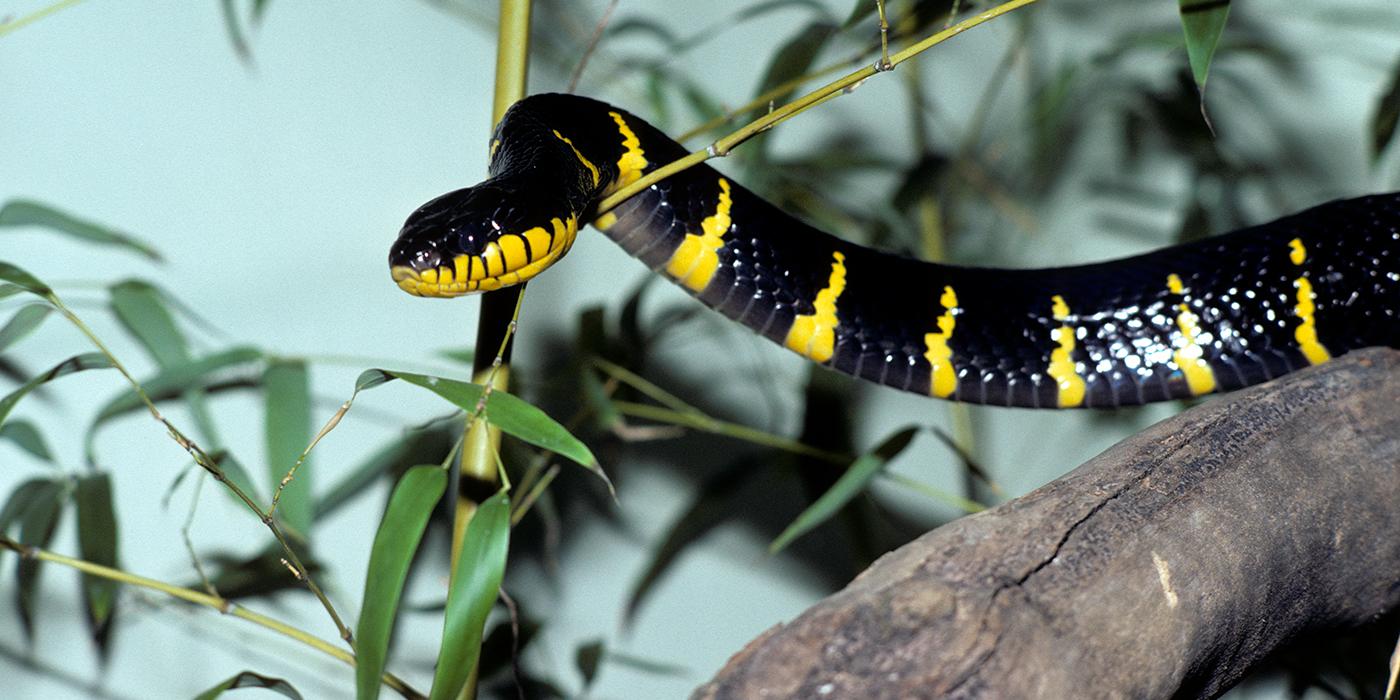The mangrove snake is a slender black snake with narrow, yellow bands along its body and around its face. This nocturnal species spends its days coiled among mangrove branches in riverine forests or overhanging coastal waters.
Physical Description
This slender snake is primarily black with yellow scales around its face and bands around its body. The yellow bands do not generally join over the back or under the belly. The mangrove snake's eyes are large with narrow, vertical slits, earning it another common name—the yellow-ringed cat snake. The eye structure allows it to see better at night when it is active and on the hunt.
The mangrove snake is mildly venomous with rear fangs. Like other members of the Colubrid family, it has a Duvernoy's gland, which is distinct from the venom gland and composed of cells that produce saliva. The Duvernoy's gland is located on the posterior end of the eye with a duct that connects to the rear fangs, which are enlarged and have grooves into which the venom flows. This is a common adaptation of rear-fanged snakes. The fangs are angled backward to assist in biting and holding onto prey, though sometimes the prey needs to be chewed for the venom to be properly injected.
The mangrove snake's toxin, called denmotoxin, is especially useful when hunting their primary prey, birds. In a 2006 study published in the Journal of Biological Chemistry, scientists found that the muscles of mice were not as susceptible to the mangrove snake's immobilizing venom as the muscles of birds. The snake's venom is not lethal to humans but can cause painful swelling and discoloration of the skin.
Native Habitat
Mangrove snakes are widely distributed across southeast Asia, including Indonesia, Malaysia, Thailand, Singapore, Vietnam, Cambodia and the Philippines. It is native, but not common, to Singapore. A population of mangrove snakes was also accidentally introduced to Texas.
Nine subspecies of mangrove snake are currently recognized by taxonomists. However, debate continues as to whether some of these are distinct species, or whether more subspecies have yet to be determined. The nine recognized subspecies occupy different parts of the snake's range and exhibit slight color variations.
Mangrove snakes are aptly named for the areas they inhabit: mangrove forests, riverine areas and lowland forests. They spend most of their time basking on tree branches 30 meters (100 feet) or higher but descend to the forest floor at night to hunt.
Food/Eating Habits
These snakes hunt a wide variety of prey, including other snakes, lizards and frogs. Most frequently, they forage for small mammals, such as bats and birds (and their eggs).
Reproduction and Development
Mangrove snakes lay their eggs in tree hollows. Their clutch size averages 10 eggs but ranges from four to 15. After a gestation period of about 45 days, the young hatch. The hatchlings are about 8 inches (20 centimeters) long and are similar in color to adults.
Help this Species
If you see a snake in the wild, leave it alone and encourage others to do the same. Don’t assume it is a venomous species, and don’t attack it if it doesn’t pose a threat to your safety. Tell your friends and family about the eco-services that snakes provide, such as keeping rodent populations in check.
Share the story of this animal with others. Simply raising awareness about this species can contribute to its overall protection.
Protect local waterways by using fewer pesticides when caring for your garden or lawn. Using fertilizers sparingly, keeping storm drains free of litter and picking up after your pet can also improve watershed health.
Smithsonian's National Zoo and Conservation Biology Institute. (n.d.). Mangrove snake. Retrieved January 4, 2026, from https://nationalzoo.si.edu/animals/mangrove-snake



